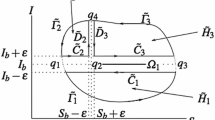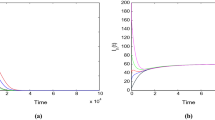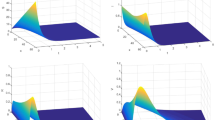Abstract
We introduce a model of avian influenza in domestic birds with imperfect vaccination and age-since-vaccination structure. The model has four components: susceptible birds, vaccinated birds (stratified by vaccination age), asymptomatically infected birds, and infected birds. The model includes reduction in the probability of infection, decreasing severity of disease of vaccinated birds and vaccine waning. The basic reproduction number, \(\mathcal R_0\), is calculated. The disease-free equilibrium is found to be globally stable under certain conditions when \({\mathcal {R}}_0<1\). When \({\mathcal {R}}_0>1\), existence of an endemic equilibrium is proved (with uniqueness for the ODE case and local stability under stricter conditions) and uniform persistence of the disease is established. The inclusion of reduction in susceptibility of vaccinated birds, reduction in infectiousness of asymptomatically infected birds and vaccine waning can have important implications for disease control. We analytically and numerically demonstrate that vaccination can paradoxically increase the total number of infected, resulting in the “silent spread” of the disease. We also study the effects of vaccine efficacy on disease prevalence and the minimum critical vaccination coverage, a threshold value for vaccination coverage to avoid an increase in total disease prevalence due to asymptomatic infection.







Similar content being viewed by others
References
Arino J et al (2004) An epidemiological model that includes a leaky vaccine with a general warning function. Disc Cont Dyn Sys-B 4:479–495
Brauer F (2004) Backward bifurcations in simple vaccination models. J Math Anal Appl 298(2):418
Desvaux S, Grosbois V, Pham TTH, Dao DT, Nguyen TD, Fenwick S, Roger F, Ellis T, Peyre M (2013) Evaluation of the vaccination efficacy against H5N1 in domestic poultry in the Red River Delta in Vietnam. Epidemiol Infect 141:776–788
Food and Agriculture Organization (2007) Avian influenza vaccination, OEI Information Document. http://www.oie.int/doc/ged/D4410.PDF
Food and Agriculture Organization (2011) Animal intervention strategies under different epidemiological and field conditions that can reduce risk of zoonotic infection, OFFLU Review Paper. http://www.offlu.net/fileadmin/home/en/human-animal-interface/pdf/Offlu_review_paper_intervention_strategies_Nov_2011.pdf
Garba SM, Gumel AB, Abu Bakar MR (2008) Backward bifurcations in dengue transmission dynamics. Math Biosci 215:11–25
Gulbudak H, Martcheva M (2013) Forward hysteresis and backward bifurcation caused by culling in an avian influenza model. Math. Biosci. 246:202–212
Gumel AB, McCluskey CC, van den Driessche P (2006) Mathematical study of a staged-progression HIV model with imperfect vaccine. Bull Math Biol 68:2105–2128
Heffernan JM, Keeling MJ (2009) Implications of vaccination and waning immunity. Proc R Soc 276:2071–2080
Hinrichs J, Otte J (2012) Large-scale vaccination for the control of avian influenza: epidemiological and financial implications. In: Zilberman D, Otte J, Roland-Holdst, Pfeiffer E (ed) Health and animal agriculture in developing countries. Springer, New York, vol 36, pp 207–231
Iwami S, Takeuchi Y, Korobeiniov A, Liu X (2008) Prevention of avian influenza epidemic: what policy should we choose? JTB 252:732–741
Iwami S, Suzuki T, Takeuchi Y (2009) Paradox of vaccination: is vaccination really effective against avian flu epidemics? PloS ONE 4:e4915
Kribs-Zaleta CM, Martcheva M (2002) Vaccination strategies and backward bifurcation in an age-since-infection structured model. Math Biosci 177 & 178, 317–332
Lee CW, Suarez DL (2005) Avian influenza virus: prospects for prevention and control by vaccination. Anim Health Res Rev 6:1–15
Peyre M, Fusheng G, Desvaux S, Roger F (2009) Avian influenza vaccines: a practical review in relation to their application in the field with a focus on the Asian experience. Epidemiol Infect 137:1–21
Pfeiffer J, Suarez DL, Sarmento L, Long To T, Nguyen T, Pantin-jackwood MJ (2010) Efficacy of Commercial Vaccines in Protecting Chickens and Ducks Against H5N1 Highly Pathogenic Avian Influenza Viruses from Vietnam. Avian Diseases 54:262–271
Savill NJ, Rose SG, Keeling MJ, Woolhouse ME (2006) Silent spread of H5N1 in vaccinated poultry. Nature 442:757
Smith HL, Waltman P (1995) The theory of the chemostat. Cambridge University Press, Cambridge
Smith R, Blower S (2004) Could disease-modifying HIV vaccines cause population-level perversity? Lancet Infect Dis 4:636–639
Swayne DE, Kapszynski D (2008) Strategies and challenges for eliciting immunity against Avian influenza virus in birds. Immunol Rev 225:314–331
Thieme H (2003) Mathematics in population biology. Princeton University Press, Princeton
Trevor ME et al (2004) Vaccination of Chickens against \(H5N1\) Avian Influenza in the face of an Outbreak Interrupts Virus Transmission. Avian Pathol J W.V.P.A 33:405–412
van der Goot JA, Koch G, de Jong MCM, van Boven M (2005) Quantification of the effect of vaccination on transmission of avian influenza (\(H7N7\)) in chickens. PNAS 102:18141–18146
Webster RG (2001) Cross-reactive, cell-mediated immunity and protection of chickens from lethal H5N1 influenza virus infection in Hong Kong poultry markets. J Virol 75:2516–2525
World Health Organization (WHO) (1993) Immunological Basis for Immunization Series Module 7: Measles. http://www.nccvmtc.org/PDF1/1_033.pdf
Acknowledgments
Maia Martcheva and Hayriye Gulbudak acknowledge partial support from NSF Grant DMS-1220342. The authors thank the referees for their helpful suggestions.
Author information
Authors and Affiliations
Corresponding author
Rights and permissions
About this article
Cite this article
Gulbudak, H., Martcheva, M. A Structured Avian Influenza Model with Imperfect Vaccination and Vaccine-Induced Asymptomatic Infection. Bull Math Biol 76, 2389–2425 (2014). https://doi.org/10.1007/s11538-014-0012-1
Received:
Accepted:
Published:
Issue Date:
DOI: https://doi.org/10.1007/s11538-014-0012-1




